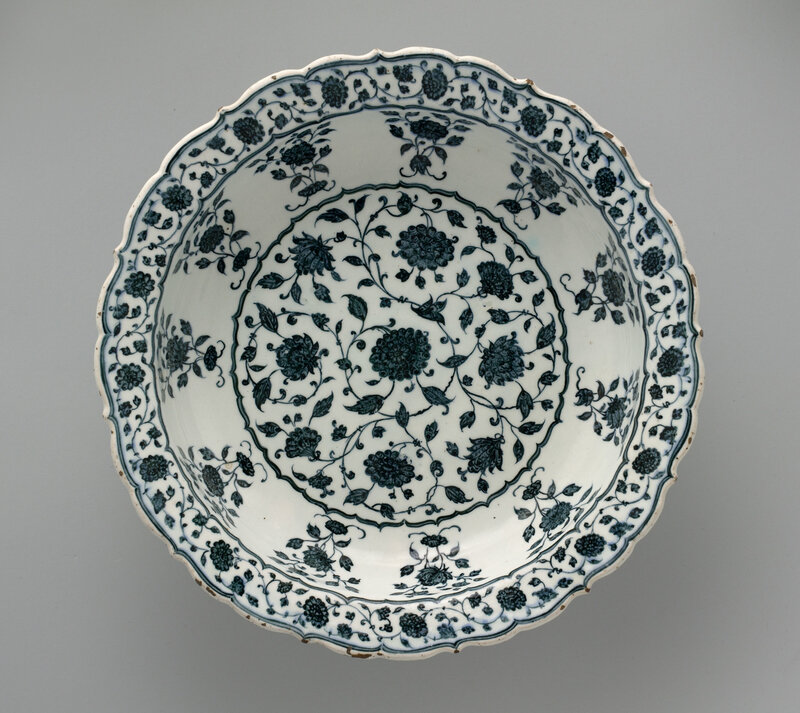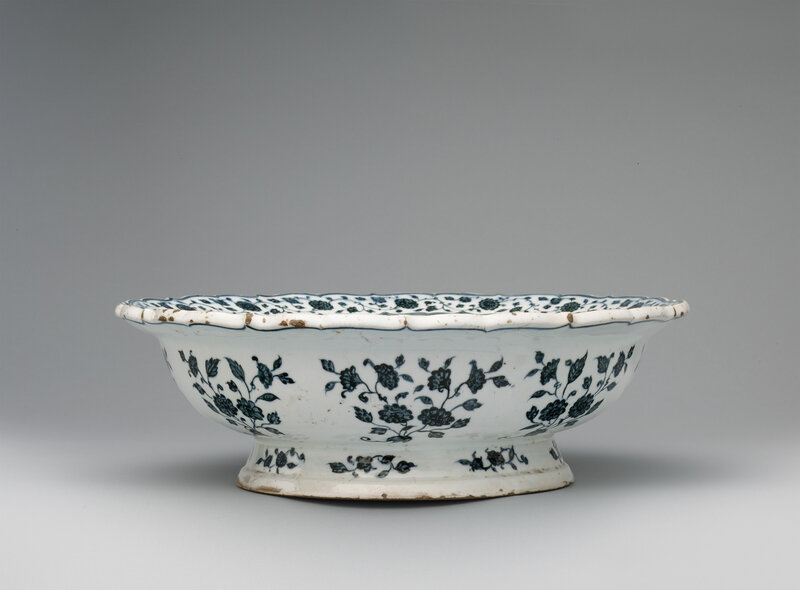Sotheby's. Arts of the Islamic World including Fine Rugs and Carpets, London, 01 May 2019, 10:30 AM
A large Iznik blue and white pottery footed dish (tazza), Turkey, circa 1560-70


Lot 217. A large Iznik blue and white pottery footed dish (tazza), Turkey, circa 1560-70;12.3cm. height, 36cm. diam. Estimate 80,000 — 120,000 GBP (92,864 - 139,296 EUR). Lot sold 100,000 GBP (115.940 EUR). Courtesy Sotheby's.
of deep rounded form with sloping bracketed rim, resting on a raised everted foot, decorated in underglaze cobalt blue and grey-blue with a central rosette surrounded by lotus palmette stems with wheatsheaf motif, the rim with en-suite design, exterior and foot with repeating similar motifs on smaller scale.
Provenance: Ex-collection George Antaki, Paris.
Literature: N. Atasoy and J. Raby, Iznik: The Pottery of Ottoman Turkey, Istanbul, 1989, pp.240-1, no.446.
Note: This majestic tazza exemplifies the important cross-cultural interactions that occurred along the silk road. Iznik potters were highly influenced by early Chinese blue and white porcelains, just as some of the large chargers that were being produced in China during the Yuan dynasty featured unique adaptations to suit Middle Eastern dining customs. A miniature depicting the use of Yuan chargers at a feast held in the Topkapi Palace, Istanbul, in the seventeenth century is illustrated by Julian Raby and Ünsal Yücel in R. Krahl, Chinese Ceramics in the Topkapi Saray Museum, Istanbul, ed. John Ayers, London, 1986, vol.1, p.45.
The origin of the design on this particular tazza can be traced back to an early fifteenth century Ming dish such as the one in the collection of the Topkapi (ibid, p.513, no.602). It is highly likely that the maker of the present tazza would have seen one of the examples of Ming pottery once preserved in the royal collections of the Safavids in Persia and Ottomans in Turkey. For examples in the Ardabil Shrine in the National Museum of Iran, Tehran, see J.A. Pope, Chinese Porcelains from the Ardebil Shrine, Washington D.C., 1956, pls.29.101, 29.106 and 29.109; and Ottoman Turkey: Krahl 1986, vol.2, pls.601 and 602.
It is interesting to compare the present example with a finely painted blue and white 'floral' charger from the Ming Dynasty, Yongle period, offered as part of the Tianminlou collection, Sotheby's Hong Kong, 3 April 2019, lot 2. Both display a similar rendering of lotus blossom palmettes with delicately scrolling stems; a motif which also reflected the Jingdezhen potters' own interpretations of foreign aesthetic taste. The distinctive 'wheatsheaf' motif, which is said to derive from a conflation of floral elements and Ming designs seems to have been popular for use on the tazza form. The earliest recorded tazza, thought to date from 1525-35, displays these same motifs in the well and on the rim (now in the Metropolitan Museum of Art, New York, inv. no. 66.4.2, illustrated in Atasoy and Raby 1989, no.208). A tazza dated to 1570 in the Turk ve Islam Eserleri Museum, Istanbul, inv. no. 802, has a very similar version of the design on this tazza (ibid, no.444).


/https%3A%2F%2Fprofilepics.canalblog.com%2Fprofilepics%2F1%2F0%2F100183.jpg)
/https%3A%2F%2Fstorage.canalblog.com%2F03%2F02%2F119589%2F96711876_o.jpg)
/https%3A%2F%2Fstorage.canalblog.com%2F11%2F31%2F119589%2F94773502_o.jpg)
/https%3A%2F%2Fstorage.canalblog.com%2F20%2F83%2F119589%2F94772815_o.jpg)
/https%3A%2F%2Fstorage.canalblog.com%2F26%2F72%2F119589%2F75604929_o.jpg)
/https%3A%2F%2Fstorage.canalblog.com%2F59%2F60%2F119589%2F26458628_o.jpg)




/image%2F1371349%2F20240421%2Fob_b39e0a_438887545-1653581928745153-28887593908.jpg)
/image%2F1371349%2F20240421%2Fob_37d5a2_437904124-1653574982079181-78090462207.jpg)
/http%3A%2F%2Fstorage.canalblog.com%2F59%2F78%2F119589%2F128999908_o.jpg)
/http%3A%2F%2Fstorage.canalblog.com%2F44%2F97%2F119589%2F128680994_o.png)